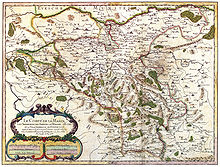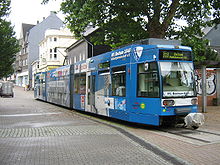Dahlhausen (Bochum)
|
Dahlhausen district of Bochum |
|
|---|---|
| Coordinates | 51 ° 25 '36 " N , 7 ° 8' 38" E |
| height | 60 m above sea level NHN |
| surface | 5.27 km² |
| Residents | 12,819 (Dec. 31, 2016) |
| Population density | 2432 inhabitants / km² |
| Incorporation | Aug 1, 1929 |
| Post Code | 44879 |
| structure | |
| district | Southwest |
| Markings |
Dahlhausen, Oberdahlhausen |
| Source: | |
Dahlhausen is a district in the southwest of Bochum , which borders the cities of Essen and Hattingen . It belongs to the district of Bochum-Südwest (VI). On the other side of the Ruhr is the Essen district of Burgaltendorf . Often, because of the name Linden-Dahlhausen, it is assumed that Dahlhausen is part of Linden, but this is not the case.
history
Dahlhausen was first mentioned in a document in 803. In the following centuries, the place was mostly in the border area of the county Mark to the Duchy of Berg . Around 1400, for example, the Dalehusen and Linden estate belonged to the Blankenstein office of the Brandenburg region . After the county of Mark was ceded to Napoleon in the Peace of Tilsit in 1807 and organized in 1808 according to French standards in the Département Ruhr , the old office of Blankenstein (and with it Dahlhausen) now belonged as part of the canton of Hattingen to the arrondissement of Hagen . After the end of the Congress of Vienna in 1815, the community was assigned to the Bochum district of the Prussian province of Westphalia .
Dahlhausen flourished in the course of industrialization in the late 19th and early 20th centuries. Various mining companies such as the Hasenwinkel colliery expanded and increased their production and new industrial companies such as the Dr. C. Otto & Comp. opened their gates. As a result, the community experienced an increase in the number of residents, triggered by the immigration of people from Hesse, the East Prussian provinces and from Poland. Thus the population rose from 387 to 13,000 between 1818 and 1921. Due to this strong population growth in the entire Bochum district, it was divided into three districts in 1885. Dahlhausen was assigned to the new Hattingen district . During this time, too, Dahlhausen was again on the border with the Prussian Rhine Province .
After the end of the First World War , Dahlhausen was merged with the neighboring community of Linden zu Linden-Dahlhausen in the first years of the Weimar Republic in 1921 . On August 1, 1929, this new community was dissolved and incorporated into Bochum.
Dahlhausen experienced another population surge at the end of the economic miracle . During this time, workers from Turkey, Italy and Portugal were added to meet the demand for workers.
Many historical buildings in Dahlhausen date from these times of rapid growth. The Burg Horkenstein excursion restaurant was built and operated on the Ruhr heights, of which only the foundation has been preserved today. There was also a river outdoor pool with a bathing island at the Ruhr weir. A little upstream the Dahlhausen floating bridge was built, a pontoon bridge to Burgaltendorf and the Dahlhausen railway bridge , which has now been closed.
Townscape
There are numerous remains of old collieries that once gave Dahlhausen its importance, such as the United Dahlhauser Tiefbau colliery or the Hasenwinkel colliery . Many disused railway lines in Dahlhausen, such as the Hasenwinkeler Kohlenweg, testify to this history . The relics of the Ruhr mining industry can be accessed locally through the Dahlhauser Bergbauwanderweg . A globally significant company from the early days is Dr. C. Otto & Comp. , which makes stones for blast furnaces and coking plants .
The former Naturfreundehaus Haus Hedtberg is still used as a hostel today.
There are also three schools. In addition to the primary school in Dahlhausen, the Rupert-Neudeck-Schule and the Theodor-Körner-Gymnasium are located in the south-west school center . The Rosalie Adler Center for Seniors provides care for the elderly. With the Luther Church and the Romanian Orthodox Church there are two churches in the local area.
There is a beer garden and a campsite at the Ruhr weir. The river open-air pool with a bathing island used to be located here. Upstream is the Dahlhausen floating bridge, which is currently closed to motorized traffic. Further Ruhr bridges can be found downstream with the disused railway bridge and the pedestrian bridge built in 1988. Hiking and cycling trails on the Ruhr as part of the Ruhrtal cycle path lead to Hattingen and Essen-Steele .
population
On December 31, 2019, 12,863 residents lived in Dahlhausen.
Structural data of the population in Dahlhausen:
- Minor quota: 15.5% [Bochum average: 14.6% (2019)]
- Old age rate (60 years and older): 30.2% [Bochum average 28.3% (2019)]
- Proportion of foreigners: 8.4% [Bochum average 14.4% (2019)]
- Unemployment rate: 7.5% [Bochum average 8.9% (2017)]
traffic
The Bochum-Dahlhausen station is now a stop on the S 3 , which it to the S-Bahn network Rhein-Ruhr is connected.
With the tram line 318, which has had its terminus here since 1901, Bochum main station and Bochum city center can be reached.
The former Bochum-Dahlhausen depot is located in Dahlhausen and was opened in 1977 as the Bochum-Dahlhausen Railway Museum .
Associations and initiatives
- The citizens' rifle club "Blau-Weiß" 05 Bochum Oberdahlhausen e. V. is one of the oldest local sports clubs. The association was founded in 1905 under the name "Adlerblick" and moved to Oberdahlhausen in 1910.
- The Linden-Dahlhauser Kanu-Club 1927 e. V. offers everything from amateur to professional sports in the canoe and dragon boat sector. There are also rental options for boats for non-club members.
- The clubhouse of the second largest swimming club in Bochum with 700 members is located in Dahlhausen - the Linden-Dahlhauser swimming club 1921 eV Swimming takes place in Bochum's Südbad, which is located in Linden.
- With the association for multicultural child and youth welfare there is an institution that u. a. is known beyond Bochum's borders for its work in preventing Salafism.
Web links
- Dahlhausen (Bochum) in the Westphalia Culture Atlas
- Bochum Railway Museum
- Hiking trail through the historic mining in Dahlhausen
Individual evidence
- ↑ Statistical yearbook of the city of Bochum 2017 ( [1] )
- ↑ The population figures are given according to statistical districts and not according to the districts, the figures for this are in the article population development of Bochum
- ↑ a b Stephanie Reekers: The regional development of the districts and communities of Westphalia 1817-1967 . Aschendorff, Münster Westfalen 1977, ISBN 3-402-05875-8 , p. 225 and 258 .
- ↑ Stadtteilladen Regenbogen (ed.): We all come from the same circumstances. From the history of labor immigration in Bochum-Dahlhausen from 1880 to today. Bochum, 1990
- ↑ Homepage of Blau-Weiß 05
- ↑ Homepage of the LDKC
- ↑ Homepage of the LDSV







